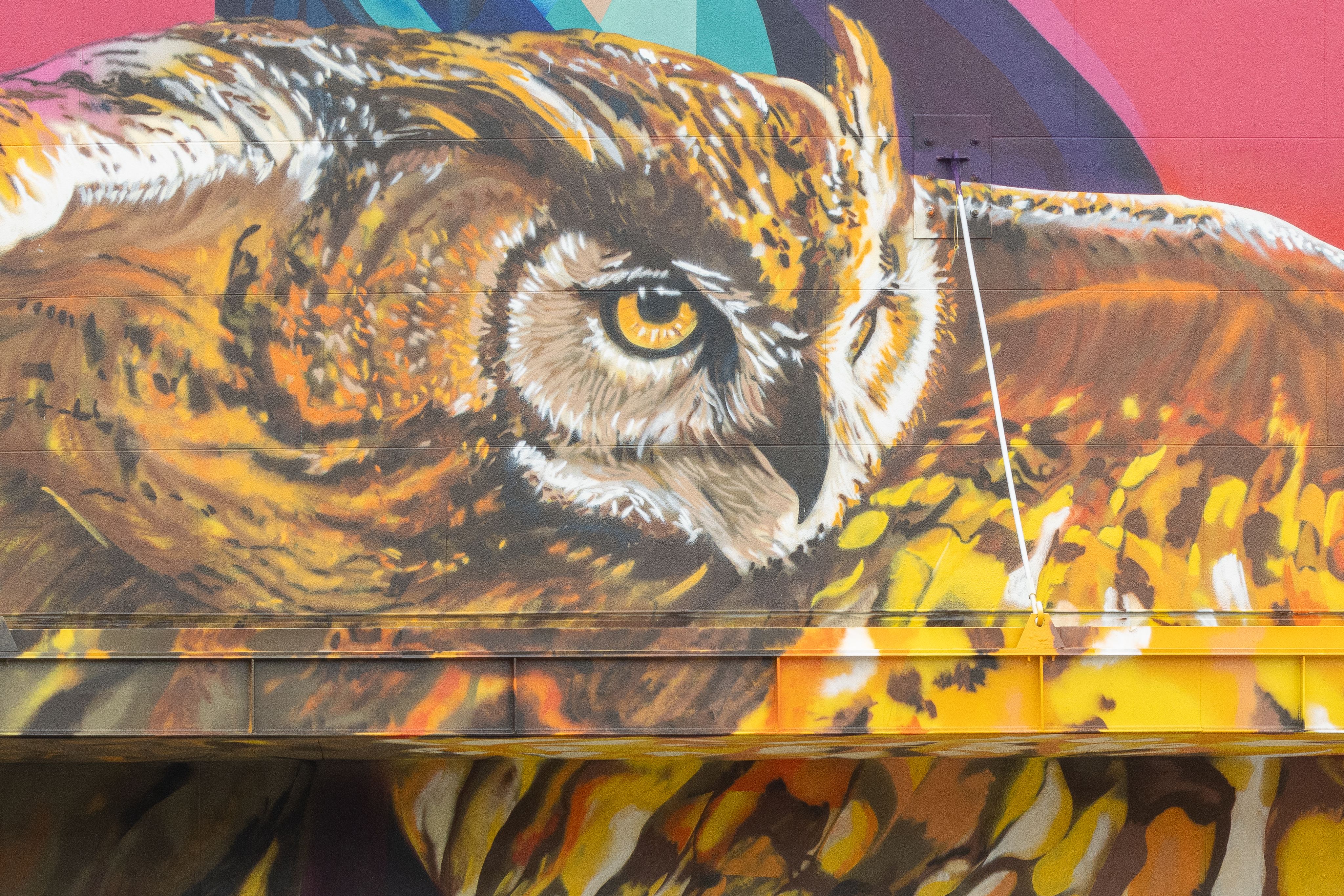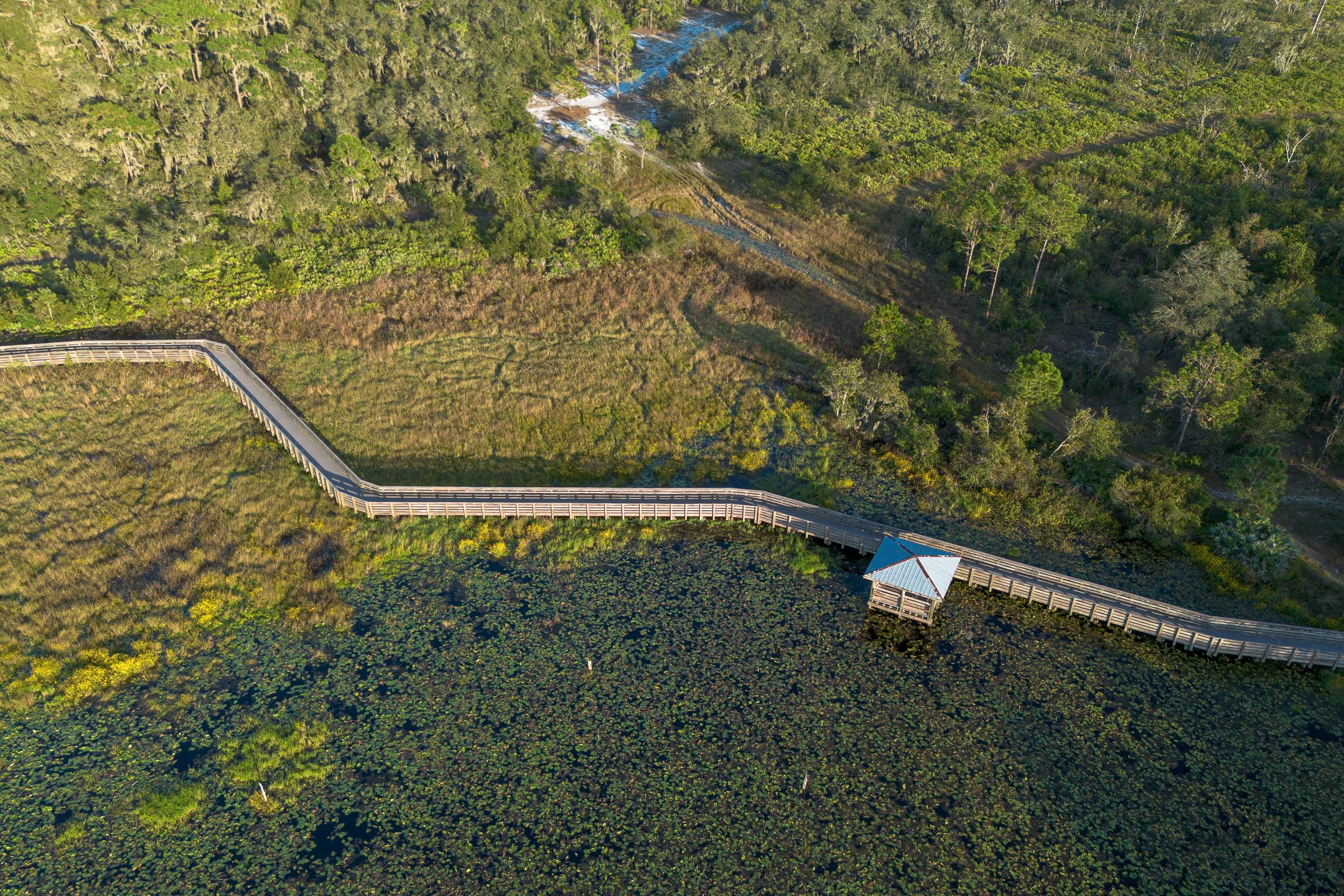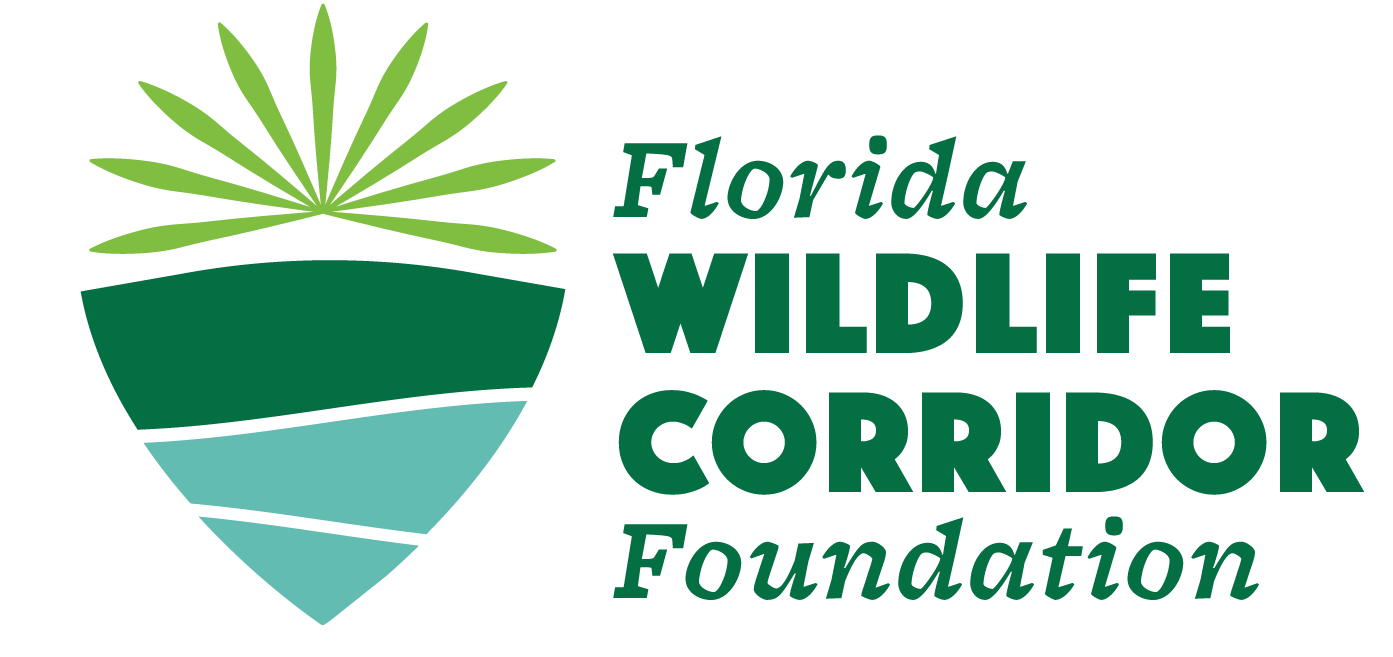Echoes of Resilience
By Artist Samara Ash

The Florida Wildlife Corridor is an 18-million-acre statewide network of connected lands and waters that supports wildlife and people.
Seen in dark green, 10 million acres are protected as federal lands, state parks and forests, county lands, water management district lands, or private lands under conservation easements.
The remaining 8 million unprotected acres in light green are opportunity areas for conservation and are mostly comprised of agricultural working lands, such as cattle ranches and timber land. Not only do these valuable spaces provide food and fiber for Florida and our nation, but they also provide interconnected landscapes that keep Florida’s wild spaces connected.
Our Mural Campaign is aimed at raising awareness of the importance of the Florida Wildlife Corridor in areas with the greatest ecological significance that have the highest risk of development by 2030.
The geography surrounding the city of Lakeland serves as vital connection points in multiple parts of the Corridor. Directly North of Lakeland is the Green Swamp which is a critical aquifer recharge area and the headwaters for 4 major rivers: the Peace, Hillsborough, Withlacoochee, and Ocklawaha. The Green Swamp and the rivers that emerge from it provide most of the drinking water to Polk and surrounding counties. The Green Swamp also connects wildlife from Central Florida to the Nature Coast.
Running directly through Lakeland is a critical connection of the Florida Wildlife Corridor which connects Saddle Creek to Lake Hancock and eventually the Peace River. This fragile connection is only a mile wide in some portions.
To the East of Lakeland along the edge of Polk County is the Kissimmee Chain of Lakes which is the headwaters of the Everglades. Water from this system meanders through the Kissimmee River to Lake Okeechobee and eventually the Everglades. This section allows wildlife to travel Northeast along the St. Johns River or South towards Lake Okeechobee.
Polk County is home to important fauna like the Florida Scrub Jay, Crested Caracara, North American River Otter, and has frequent Florida Panther sightings. Protecting wild spaces in Polk County not only gives these species room to roam, but allows locals and visitors alike to enjoy an abundance of outdoor recreational activities such as hiking, biking, kayaking, camping, hunting, and fishing.
Polk County is the fastest growing county in the nation and with this massive influx of people means more development of the wild spaces we know and love. Without thoughtful conservation and planning the connected landscape will be lost, resulting in diminished wildlife populations, degraded water quality and negative impacts on the outdoor recreation and ecotourism important to the local economy.
Meet The Artist
Samara Ash, born in Bogota, Colombia, is an artist based in Miami, Florida who and travels extensively to create large-scale public artworks. She is a resident artist both at FountainHead Studios, in Little River, Florida and the Koubek Center at Miami Dade College.
Ash graduated as Valedictorian from The University of Florida through the New World School of the Arts (2008) where she earned a Dual BFA in Painting and Electronic Intermedia along with a Minor in Art History.
Ash is an interdisciplinary artist that works across mediums with power & frailty as a subject matter. Through her work, she hopes to create a space for dialogue and exploration of the complexities of these two concepts. Incorporating painting, photography, and installation into her practice; Ash draws inspiration from personal experiences of potentiality and weakness.

"Echoes of Resilience" by Samara Ash showcases the iconic flora and fauna found in and around Lakeland and Polk County.
The Florida Fish and Wildlife Conservation Commission (FWC) manages fish and wildlife resources for their long-term well-being and the benefit of people. Thanks to their contributions, you can learn more about the species in this mural. Scroll to learn about each of the species featured.
Photo by Ethan Coyle
Photo by Ethan Coyle
Great Horned Owl
(Bubo virginianus)
The great horned owl is the largest of Florida's owls at 18 to 25 inches tall. They have tall "ear tufts" and large yellow eyes that make them easily recognizable when seen during daylight hours.
They are found throughout Florida and roost in large, messy nests, in tall trees. Great horned owls don't build their own nests, so they often take over old nests from other birds. They are very adaptable and comfortable in both park settings and rural areas.
Great horned owls have the most diverse diet of any North American raptor, eating things like rodents, insects, and other birds.
Photo by Alexis Madrid
Photo by Alexis Madrid
Monarch Butterfly
(Danaus plexippus)
Monarch butterflies are the most familiar North American butterfly. Larvae feed on the milkweed family of plants and sequester toxic chemicals that render them distasteful to certain predators. The bold black and orange coloration advertise this toxicity.
Historically, the Eastern migratory population of Monarchs moved through the Panhandle and North Florida on its annual journey to Central Mexico. However, some of these Monarchs have deviated from their route and settled permanently in South Florida.
This disruption is primarily due to the widespread cultivation of non-native tropical milkweed which carries a detrimental parasite. You can help Monarchs by removing any planted tropical milkweed and planting Florida’s native milkweeds including white swamp milkweed, butterflyweed , and pineland milkweed.
Photo by Ethan Coyle
Photo by Ethan Coyle
Bald Cypress
(Taxodium distichum)
Bald Cypress trees tend to grow in forested wetlands, along streams and rivers, in spring runs and ponds, and in places with still or slow-moving water. Bald Cypresses are the most flood-tolerant of all Florida's trees, which is why they dominate swamps that have long flood periods. Bald Cypress swamps are home to many species, with large mammals and birds especially take advantage of the plant density and hollow trees of the swamps.
They are known for their pneumatophores (knees) which function to transport air to drowned roots underground and their buttressed (flared) trunks which both work together to keep the tree stable in its wet environment. Bald Cypress trees can grow up to 150 feet and reach six feet in diameter and have flat leaves that grow on both sides of the branchlets.
Photo by Ethan Coyle
Photo by Ethan Coyle
American Alligator
(Alligator mississippiensis)
Alligators have inhabited Florida's marshes, swamps, rivers and lakes for many centuries, and are found in all 67 counties. There are an estimated 1.3 million Alligators in Florida.
Alligators are opportunistic feeders. Their diets include prey species that are abundant and easily accessible. Juvenile alligators eat primarily insects, amphibians, small fish, and other invertebrates. Adult alligators eat rough fish, snakes, turtles, small mammals, and birds.
Alligators are ectothermic (cold blooded). They regulate their body temperature by basking in the sun or moving to areas with warmer or cooler air or water temperatures. They are most active when temperatures are between 82° to 92° F. They stop feeding when the ambient temperature drops below approximately 70° F, and they become dormant below 55° F. Alligators are dormant throughout much of the winter. During this time, they can be found in burrows that they construct adjacent to an alligator hole or open water, but they occasionally emerge to bask in the sun during periods of warm weather.
Photo by Ana G Hidalgo
Photo by Ana G Hidalgo
Roseate Spoonbill
(Platalea ajaja)
The roseate spoonbill is the only spoonbill native to the Western Hemisphere. This species can reach a length of 30-40 inches with a wingspan of 50-53 inches. It has pink wings and underparts with a white neck and back, pinkish legs and feet, and no feathers on their heads.
Roseate Spoonbills get get their iconic pink color from the carotenoids that are found in their diet, which primarily consists of crayfish, shrimp, crabs, and small fish. As the name implies, the roseate spoonbill also has a large, spoon-shaped bill, which it sweeps back and forth in shallow water to capture prey. The specialized bill has sensitive nerve endings which help the birds search for food in shallow water.
Historically the largest threat to the roseate spoonbill was hunting for their feathers, which is now illegal, allowing the population to rebound. They are currently a state-designated threatened species because of factors like habitat loss and degradation, pesticides, and illegal shootings.
Photo by Ethan Coyle
Photo by Ethan Coyle
Pied-billed Grebe
(Podilymbus podiceps)
Pied-billed Grebes are small swimming birds with compact bodies and slender necks. They have a relatively large head and short, thick bill with virtually no tail. Breeding adults have a black stripe on their bill giving them their name "pied-billed".
The most widespread grebe in the Americas, they are mainly a migratory species but have some populations living in Florida year-round. These birds are highly adapted for the water and are found in ponds, lakes, and marshes. They are rarely seen on land and are clumsy when out of the water. Grebes dive for their meals, swimming underwater for insects, crustaceans, small amphibians, or fish.
Young are fed by both parents and often ride on parents' backs when small; adults may swim underwater with young on back.
Photo by Ethan Coyle
Photo by Ethan Coyle
North American River Otter
(Lontra canadensis)
This water-loving animal is found throughout Florida except the Keys. River otters usually prefer fresh water and can be found in rivers, creeks, lakes, ponds, and swamps. Otters live in burrows on the bank of the water body, often under tree roots. They may dig their own burrow or remodel a beaver’s burrow.
The river otter is adapted for both land and water with short legs, webbed toes, and a strong, flattened tail. Otters have five toes and the heel pad tends to be somewhat horseshoe shaped. The ears appear large on its small flattened head. River otter fur ranges from light to dark, rich brown.
River otters are mostly nocturnal and feed on shellfish and fish. They are social animals, and groups usually consist of a female and her juvenile offspring.
Photo by Alex Freeze
Photo by Alex Freeze
Florida Panther
(Puma concolor coryi)
The Florida panther, Florida's official state animal, has been listed as a federally endangered species since 1967. Currently there are approximately 120-230 adult panthers in the population. Their historic range once extended across the southeast from Florida to Louisiana all the way to Arkansas, but now the core population is found south of Lake Okeechobee.
Florida panthers are a subspecies of the North American mountain lion (cougar). They are large, tan cats—their bodies are mainly covered in tawny-beige fur, except for the whitish-gray belly and chest. Black markings decorate the tip of the tail, ears, and around the snout.
As the state grows, suitable habitat for panthers and other wildlife shrinks. Florida panthers normally live in remote, undeveloped areas, but as both the number of panthers and the number of people living and recreating in Florida grows, so does the chance of an encounter with a panther.
Photo by Ethan Coyle
Photo by Ethan Coyle
Southern Live Oak
(Quercus virginiana)
The live oak is one of those plants that is inseparable from Florida’s identity. Since live oaks live for hundreds of years, several generations get to enjoy each majestic, sprawling tree that is draped with moss. These trees provide many ecosystem services and habitat for many species. They are massive trees that can reach 60-80 feet tall and up to 60-120 feet wide when under the right conditions.
Live oaks possibly get their name because, unlike most other deciduous oaks which drop their leaves in the winter and might look dead, live oaks lose and replace their leaves gradually throughout the year and so look "live".
Unlike many other oak trees, live oaks have narrow, smooth-edged leaves. The edges of these shiny, thick, dark green leaves often curl under. The thick, waxy coating and curling help the tree conserve moisture during the long, hot summers.
The Lakeland Mural was made possible by the following
Sponsors:
Partners:















